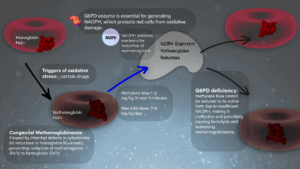The Summer 2025 issue of the SPPM Newsletter is now available online. Please CLICK HERE to view the new issue. If you or someone from your institution are interested in contributing to the SPPM Newsletter, please email me at: [email protected] This is an excellent opportunity to involve some of the younger faculty at your institutions. Enjoy […]
QUESTION OF THE MONTH/VISUAL PEARLS/POLLS OF THE MONTH
JUNE 2025 VISUAL PEARL
Visual Pearl created by Carole Lin, MD with editing assistance from Rita Agarwal, MD, FAAP, Andrew Dinh, MD and Rachel Pedreira, MD - All from Stanford University
JUNE 2025 QUESTION OF THE MONTH
Question Authors: Blossom Dharmaraj, Medical Student, McMaster University and Deepa Kattail, MD, MHS, FAAP, The Hospital for Sick Children
Question Editor: Rita Agarwal, MD, FAAP, Stanford University
A 12‑year‑old male with a known history of congenital methemoglobinemia presents for bilateral inferior alveolar nerve blocks to facilitate extraction of multiple impacted molars. He has no prior anesthetic history and is otherwise healthy. His preoperative hemoglobin is 14.6 g/dL, and his baseline methemoglobin level ranges from 2 % to 14 %. Which of the following is the most appropriate anesthetic management strategy for this patient?
A. Proceed with bilateral inferior alveolar nerve blocks using 4 % prilocaine with epinephrine, without additional monitoring.
B. Avoid all local anesthetics and use GA with volatile anesthetics.
C. Perform the nerve blocks under ultrasound guidance using ropivacaine, implement continuous or serial methemoglobin monitoring, and have methylene blue immediately available.
D. Use topical benzocaine spray to supplement a single-shot inferior alveolar block to minimize injection volume.






 SPPM 13th Annual Meeting
SPPM 13th Annual Meeting